Bolivian Rams from South America are loved by aquarists around the world. These unusual and brightly colored fish will adorn any tropical aquarium.
General Information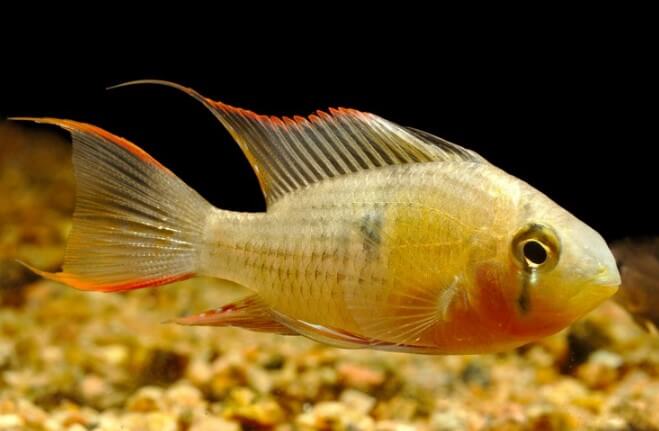
Bolivian Ram (Mikrogeophagus altispinosus) is a freshwater ray-finned fish from the Tsichlov family. The species was first described in the scientific literature more than a century ago – in 1911. The taxonomic position of the species has changed several times, at the moment it belongs to the genus Microgeophagus. True, the historical name “altispinosus” is firmly entrenched in the fish.
Bolivian Ram is a dwarf cichlid that does not grow more than 8 cm in length. She is peaceful and has an interesting bright color and body shape.
Despite their modest size, the fish are highly intelligent. They are able to recognize their master, form strong pairs, and have a pronounced parental instinct.
Bolivian Ram works well for community aquariums.
The fish is not difficult to care for and can be recommended for novice aquarists.
Appearance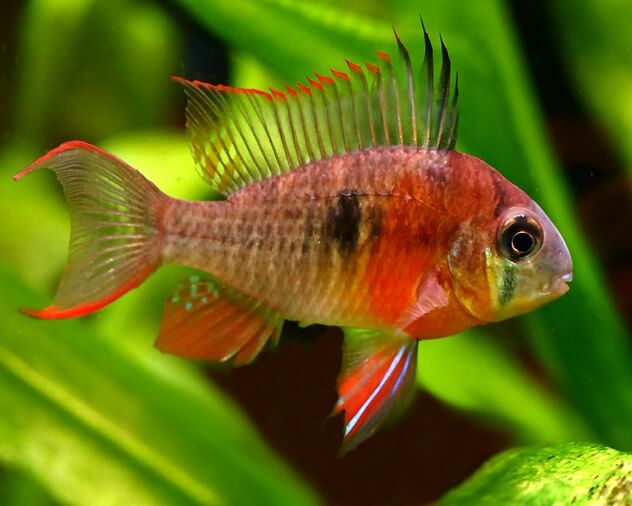
Bolivian Ram has an ovoid elongated body up to 8 cm long. Its main color is pale yellow, the head and chest are bright oranges. Directly in the middle of the body, on the sides, there is a dark, rounded spot, behind which noticeable gray stripes stretch towards the tail.
The eyes are large; a dark vertical stripe passes through them.
The dorsal fin is long and pointed, especially in adult males. A red border stretches along the upper part, and the extreme rays of the caudal fin are similarly colored. The fins themselves are transparent.
Habitat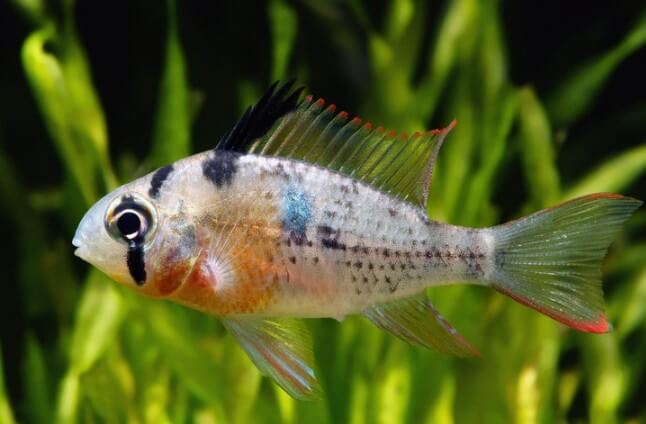
The homeland of this fish is the tropical waters of South America. The fish can be found in the vast territory of Brazil and Bolivia. The first species of this fish were caught in Bolivia, for which the fish got its name. Bolivian Rams are found in numerous backwaters, oxbows, lakes with a slow current, and a sandy bottom. The fish prefers to live in shallow water, where it finds shelter among driftwood and thickets of aquatic plants. Spends most of the time in search of insects living at the bottom.
Care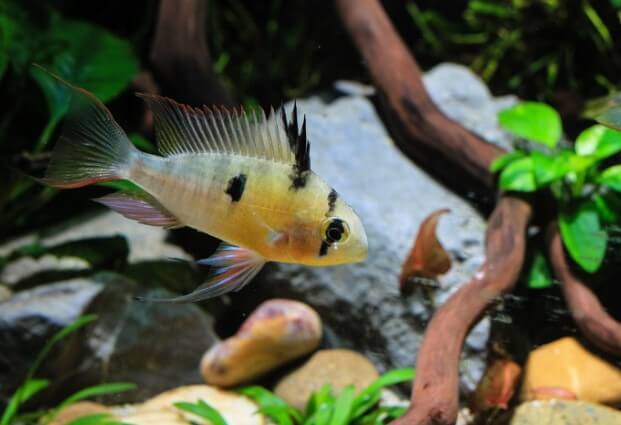
When keeping Bolivian Ram, it is recommended that you adhere to the rule that one fish has 20 liters of water. You can also put a couple of fish in the aquarium, but it is better if it is a small group of 6-8 individuals.
These fish are very fond of digging in the ground. The fish will look great among natural decorations – stones, snags, and living plants. The latter should be planted in islands, not forgetting to leave a place for swimming. Bolivian Rams do not damage plant leaves, so you can use any species you like: Vallisneria, Hygrophila, Ambulia, Bacopa, Echinodorus, Cryptocoryne, etc. Bolivian Rams love the dim lighting, so it would be useful to launch a hornwort, pistia, or Riccia on the surface of the water in the aquarium. The more hiding places in the aquarium, the better. You can build them using existing decorations, or add ceramic pots and coconut halves. Be sure to place a few flat stones on the bottom, it is possible that they will be an excellent place for spawning fish.
Clean water is the key to the well-being of the Bolivian Ram. Be sure to install a suitable filter in the aquarium and ensure proper aeration. Once a week, a freshwater change will be required. It should be 20% of the volume of the aquarium. The water from the central water supply is completely unsuitable for keeping fish, therefore, before changing it, it is necessary to make it safe for the inhabitants. To maintain a comfortable temperature for these fish, you need a thermostat.
In its natural environment, Bolivian Ram lives in reservoirs with a high content of humic substances, so it is useful to add a conditioner with natural peat extract to the water, which creates the effect of “black” tropical water.
Feeding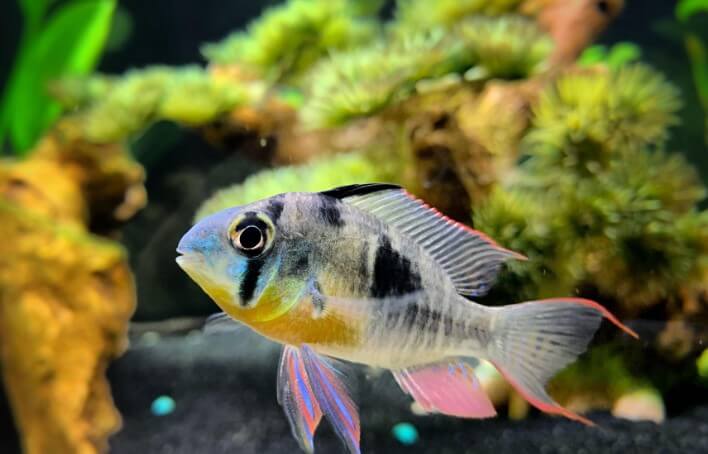
In nature, Bolivian Ram feeds on various invertebrates that it digs from the bottom. At home, the best option would be to feed the fish with high-quality dry food. Unlike live or frozen food, they are completely balanced and, thanks to the complex of vitamins, ensure the health and longevity of your pets. And it is very easy to bring an infection into the aquarium with live food, which cannot be said about dry food. It is advisable to feed these fish in small portions to avoid overeating.
Reproduction and Breeding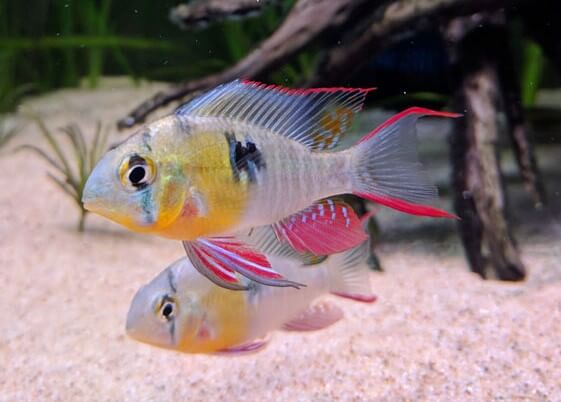
To breed the Bolivian Ram at home, you will need a separate spawning tank as other fish can eat the fry in a regular tank. Gender dimorphism in this fish is not pronounced. A pubertal male (about a year old) can be identified by its larger body size, elongated fins, and brighter color. It is not recommended to create a pair artificially, in most cases this will lead to the rejection of spawning or destruction of the clutch. It is better to plant a group of fish in an aquarium of a suitable size and let them choose their partner. Couples like these are unusually strong. The spawning aquarium should be filled with shallow soil, a large flat stone, and a group of small-leaved plants. Ideally, the container should be at least 60 liters.
You can stimulate fish to spawn with small daily water changes and raising the temperature to 27-28 ° C. If the couple is ready to spawn, they will begin clearing the spawn area, usually a flat rock. Then the female lays from 100 to 200 eggs, which are fertilized by the male immediately. The burden of caring for the offspring lies on the shoulders of both parents. The main watch is carried by the female, the male replaces her during feeding. Parents fan the eggs with their fins, creating a stream of water, and also remove the dead.
The incubation of eggs is short-lived, takes only 2-4 days. The newly born fry feed on the yolk sac for about a week, after which they switch to self-feeding. At first, young parents protect their newly-born offspring.


Fish required hi